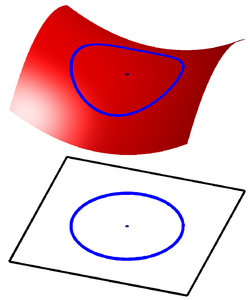Spherical mean
In mathematics, the spherical mean of a function around a point is the average of all values of that function on a sphere of given radius centered at that point.
Definition
Consider an open set U in the Euclidean space Rn and a continuous function u defined on U with real or complex values. Let x be a point in U and r > 0 be such that the closed ball B(x, r) of center x and radius r is contained in U. The spherical mean over the sphere of radius r centered at x is defined as
- [math]\displaystyle{ \frac{1}{\omega_{n-1}(r)}\int\limits_{\partial B(x, r)} \! u(y) \, \mathrm{d} S(y) }[/math]
where ∂B(x, r) is the (n − 1)-sphere forming the boundary of B(x, r), dS denotes integration with respect to spherical measure and ωn−1(r) is the "surface area" of this (n − 1)-sphere.
Equivalently, the spherical mean is given by
- [math]\displaystyle{ \frac{1}{\omega_{n-1}}\int\limits_{\|y\|=1} \! u(x+ry) \, \mathrm{d}S(y) }[/math]
where ωn−1 is the area of the (n − 1)-sphere of radius 1.
The spherical mean is often denoted as
- [math]\displaystyle{ \int\limits_{\partial B(x, r)}\!\!\!\!\!\!\!\!\!-\, u(y) \, \mathrm{d} S(y). }[/math]
The spherical mean is also defined for Riemannian manifolds in a natural manner.
Properties and uses
- From the continuity of [math]\displaystyle{ u }[/math] it follows that the function [math]\displaystyle{ r\to \int\limits_{\partial B(x, r)}\!\!\!\!\!\!\!\!\!-\, u(y) \,\mathrm{d}S(y) }[/math] is continuous, and that its limit as [math]\displaystyle{ r\to 0 }[/math] is [math]\displaystyle{ u(x). }[/math]
- Spherical means can be used to solve the Cauchy problem for the wave equation [math]\displaystyle{ \partial^2_t u=c^2\,\Delta u }[/math] in odd space dimension. The result, known as Kirchhoff's formula, is derived by using spherical means to reduce the wave equation in [math]\displaystyle{ \R^n }[/math] (for odd [math]\displaystyle{ n }[/math]) to the wave equation in [math]\displaystyle{ \R }[/math], and then using d'Alembert's formula. The expression itself is presented in wave equation article.
- If [math]\displaystyle{ U }[/math] is an open set in [math]\displaystyle{ \mathbb R^n }[/math] and [math]\displaystyle{ u }[/math] is a C2 function defined on [math]\displaystyle{ U }[/math], then [math]\displaystyle{ u }[/math] is harmonic if and only if for all [math]\displaystyle{ x }[/math] in [math]\displaystyle{ U }[/math] and all [math]\displaystyle{ r\gt 0 }[/math] such that the closed ball [math]\displaystyle{ B(x, r) }[/math] is contained in [math]\displaystyle{ U }[/math] one has [math]\displaystyle{ u(x)=\int\limits_{\partial B(x, r)}\!\!\!\!\!\!\!\!\!-\, u(y) \, \mathrm{d}S(y). }[/math] This result can be used to prove the maximum principle for harmonic functions.
References
- Evans, Lawrence C. (1998). Partial differential equations. American Mathematical Society. ISBN 978-0-8218-0772-9.
- Sabelfeld, K. K.; Shalimova, I. A. (1997). Spherical means for PDEs. VSP. ISBN 978-90-6764-211-8.
- Spherical means and geodesic chains in a Riemannian manifold. 267. 1981. pp. 483–501. doi:10.1090/S0002-9947-1981-0626485-6.
External links
 |


